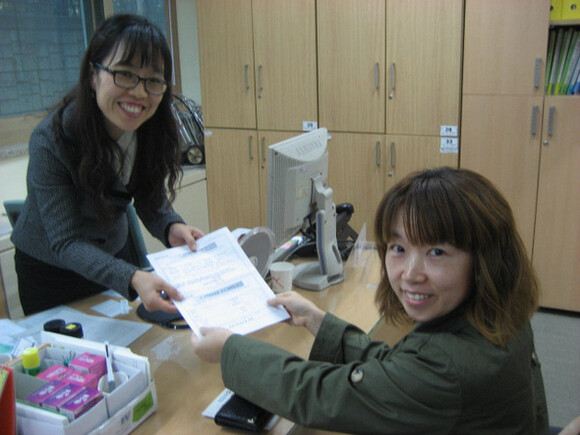hankyoreh
Links to other country sites 다른 나라 사이트 링크
Villages paying parents to encourage childbirth

By Oh Yoon-joo, Cheongju correspondent
“We feel like we just won the lottery. Our third child is a big bundle of luck.”
Father and mother Shin Gyeong-cheol, 43, and Kim Hye-sook, 40, jumped for joy when they were notified on Feb. 4 that they were eligible to receive a childbirth incentive worth 10 million won (US$9,176) from Goesan County, North Chungcheong province. The couple already received 2 million won (US$1,838) to congratulate them on the birth of the twins Eun-bi and Eun-seo on Jan. 25, 2012, and the 10 million won will be provided because Eun-seo is their third child.
According to a county ordinance related to policies to increase the population, Goesan County will provide 10 million won in installments over the course of four years. This ordinance provides 25,000 won in monthly health insurance payments for five years for the second child and above and also includes a congratulatory sum of 300,000 when the third child and above enter elementary school.
Local governments all over Korea are scrambling to produce policies of providing birth incentives for families to have three or more children as Goesan County has done.
Uljin County in North Gyeongsang province provides 6 million won (US$5,515) altogether (in monthly installments of 100,000 won over the course of five years) for a third child and above. On top of this, North Gyeongsang province also provides 100,000 won a month for a year (1.2 million won in total). Including an additional 100,000 won in monthly health insurance (which can be cashed in for 5.04 million won at the end of the term), parents can receive up to 12.04 million won. Starting with the fourth child, there are monthly payments of 200,000 won for five years, which adds up to as much as 18.24 million won (US$16,770) in total subsidies. This is the largest scale of subsidies available in Korea.
In Hampyeong County in South Jeolla province, 12 million won is provided for the third child, with up to 13 million won in subsidies for the fourth child and above. Bonghwa Province in North Gyeongsang province offers 12 million won for the third child and above.
“The baby bonus is having an effect, with around 20 new children being born each year,” said Kim Gi-cheol, the official in charge of measures to address the low birthrate in Uljin County.
However, not everyone is so optimistic. “More than 90% of local governments across Korea are employing birth incentive payment policies, but this doesn’t seem to be acting as a direct, decisive factor in encouraging people to give birth,” said Jung Young-hak, official in the department of childbirth policy at the Ministry of Health and Welfare.
“Improving the environment for raising children and other systemic changes are much more effective than a policy of providing a one-time incentive for giving birth,” argued Choi Eun-young, a professor in the department of children’s welfare at Chungbuk National University.
Please direct questions or comments to [english@hani.co.kr]

Editorial・opinion
![[Guest essay] Amending the Constitution is Yoon’s key to leaving office in public’s good graces [Guest essay] Amending the Constitution is Yoon’s key to leaving office in public’s good graces](https://flexible.img.hani.co.kr/flexible/normal/500/300/imgdb/original/2024/0416/8917132552387962.jpg) [Guest essay] Amending the Constitution is Yoon’s key to leaving office in public’s good graces
[Guest essay] Amending the Constitution is Yoon’s key to leaving office in public’s good graces![[Editorial] 10 years on, lessons of Sewol tragedy must never be forgotten [Editorial] 10 years on, lessons of Sewol tragedy must never be forgotten](https://flexible.img.hani.co.kr/flexible/normal/500/300/imgdb/original/2024/0416/8317132536568958.jpg) [Editorial] 10 years on, lessons of Sewol tragedy must never be forgotten
[Editorial] 10 years on, lessons of Sewol tragedy must never be forgotten- [Column] A death blow to Korea’s prosecutor politics
- [Correspondent’s column] The US and the end of Japanese pacifism
- [Guest essay] How Korea turned its trainee doctors into monsters
- [Guest essay] As someone who helped forge Seoul-Moscow ties, their status today troubles me
- [Editorial] Koreans sent a loud and clear message to Yoon
- [Column] In Korea’s midterm elections, it’s time for accountability
- [Guest essay] At only 26, I’ve seen 4 wars in my home of Gaza
- [Column] Syngman Rhee’s bloody legacy in Jeju
Most viewed articles
- 1Korea ranks among 10 countries going backward on coal power, report shows
- 2[Guest essay] Amending the Constitution is Yoon’s key to leaving office in public’s good graces
- 3[Guest essay] How Korea turned its trainee doctors into monsters
- 4[Editorial] 10 years on, lessons of Sewol tragedy must never be forgotten
- 5[Column] A death blow to Korea’s prosecutor politics
- 6Faith in the power of memory: Why these teens carry yellow ribbons for Sewol
- 7‘National emergency’: Why Korean voters handed 192 seats to opposition parties
- 8How Samsung’s promises of cutting-edge tech won US semiconductor grants on par with TSMC
- 9Depression a reality in Korean workplace
- 10[News analysis] Watershed augmentation of US-Japan alliance to put Korea’s diplomacy to the test